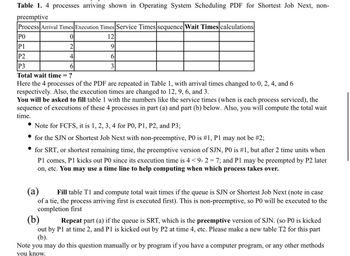
Computer Networking: A Top-Down Approach (7th Edition)
7th Edition
ISBN: 9780133594140
Author: James Kurose, Keith Ross
Publisher: PEARSON
expand_more
expand_more
format_list_bulleted
Question

Transcribed Image Text:Table 1. 4 processes arriving shown in Operating System Scheduling PDF for Shortest Job Next, non-
preemptive
Process Arrival Times Execution Times Service Times sequence Wait Times calculations
PO
0
12
P1
21
9
P2
41
6
P3
6
3
Total wait time = ?
Here the 4 processes of the PDF are repeated in Table 1, with arrival times changed to 0, 2, 4, and 6
respectively. Also, the execution times are changed to 12, 9, 6, and 3.
You will be asked to fill table 1 with the numbers like the service times (when is each process serviced), the
sequence of executions of these 4 processes in part (a) and part (b) below. Also, you will compute the total wait
time.
Note for FCFS, it is 1, 2, 3, 4 for P0, P1, P2, and P3;
• for the SJN or Shortest Job Next with non-preemptive, PO is #1, P1 may not be #2;
for SRT, or shortest remaining time, the preemptive version of SJN, PO is #1, but after 2 time units when
P1 comes, P1 kicks out PO since its execution time is 4 < 9- 2 = 7; and P1 may be preempted by P2 later
on, etc. You may use a time line to help computing when which process takes over.
(a)
Fill table T1 and compute total wait times if the queue is SJN or Shortest Job Next (note in case
of a tie, the process arriving first is executed first). This is non-preemptive, so PO will be executed to the
completion first
(b)
Repeat part (a) if the queue is SRT, which is the preemptive version of SJN. (so PO is kicked
out by P1 at time 2, and P1 is kicked out by P2 at time 4, etc. Please make a new table T2 for this part
(b).
Note you may do this question manually or by program if you have a computer program, or any other methods
you know.
Expert Solution
This question has been solved!
Explore an expertly crafted, step-by-step solution for a thorough understanding of key concepts.
This is a popular solution
Trending nowThis is a popular solution!
Step by stepSolved in 4 steps

Knowledge Booster
Similar questions
- a. b. C. d. e. f. After many insertions and deletions of items to a circular queue; the final status looks like the figure given below: myFront = 4 and myBack = 2 1 myBack 0 X P A D 3 How many items are in the circular queue? What are the items? (Write characters) What is the front item (letter) in the queue? What is the rear item (letter) in the queue? If 'F' is inserted in the existing queue; what will be the value of myBack and myFront? myFront = and myBack = If the front item is removed; myBack? myFront = myFront what will be the value of myFront and and myBack =arrow_forwardBuild a Binary Search Tree with the given input order. You must show step by step process of inserting the inputs including both recursive calls and tree diagrams for each step. [ refer to the Insertitem function of Lecture 10 slides to get an idea of doing this.] N.B: Unique Input orders for each student to build the tree are given on a separate file. Write down the input order on your answer script before answering the question. You must use the assigned input order. Do not change the order. TREE INPUT: 4,1,9,3,2,5,6,8,7arrow_forwardS1 and S2 are two sorted stacks of n and m numbers sorted in decreasing order, with their top items pointing to the smallest in their lists, respectively. Create a stack MERGE that merges the items in stacks S1 and S2, so that at the conclusion of the merge, all of the elements in S1 and S2 are available in MERGE in decreasing order, with the largest element at the top.Keep in mind that the number of components in stack MERGE is (n + m).arrow_forward
arrow_back_ios
arrow_forward_ios
Recommended textbooks for you
 Computer Networking: A Top-Down Approach (7th Edi...Computer EngineeringISBN:9780133594140Author:James Kurose, Keith RossPublisher:PEARSON
Computer Networking: A Top-Down Approach (7th Edi...Computer EngineeringISBN:9780133594140Author:James Kurose, Keith RossPublisher:PEARSON Computer Organization and Design MIPS Edition, Fi...Computer EngineeringISBN:9780124077263Author:David A. Patterson, John L. HennessyPublisher:Elsevier Science
Computer Organization and Design MIPS Edition, Fi...Computer EngineeringISBN:9780124077263Author:David A. Patterson, John L. HennessyPublisher:Elsevier Science Network+ Guide to Networks (MindTap Course List)Computer EngineeringISBN:9781337569330Author:Jill West, Tamara Dean, Jean AndrewsPublisher:Cengage Learning
Network+ Guide to Networks (MindTap Course List)Computer EngineeringISBN:9781337569330Author:Jill West, Tamara Dean, Jean AndrewsPublisher:Cengage Learning Concepts of Database ManagementComputer EngineeringISBN:9781337093422Author:Joy L. Starks, Philip J. Pratt, Mary Z. LastPublisher:Cengage Learning
Concepts of Database ManagementComputer EngineeringISBN:9781337093422Author:Joy L. Starks, Philip J. Pratt, Mary Z. LastPublisher:Cengage Learning Prelude to ProgrammingComputer EngineeringISBN:9780133750423Author:VENIT, StewartPublisher:Pearson Education
Prelude to ProgrammingComputer EngineeringISBN:9780133750423Author:VENIT, StewartPublisher:Pearson Education Sc Business Data Communications and Networking, T...Computer EngineeringISBN:9781119368830Author:FITZGERALDPublisher:WILEY
Sc Business Data Communications and Networking, T...Computer EngineeringISBN:9781119368830Author:FITZGERALDPublisher:WILEY

Computer Networking: A Top-Down Approach (7th Edi...
Computer Engineering
ISBN:9780133594140
Author:James Kurose, Keith Ross
Publisher:PEARSON

Computer Organization and Design MIPS Edition, Fi...
Computer Engineering
ISBN:9780124077263
Author:David A. Patterson, John L. Hennessy
Publisher:Elsevier Science

Network+ Guide to Networks (MindTap Course List)
Computer Engineering
ISBN:9781337569330
Author:Jill West, Tamara Dean, Jean Andrews
Publisher:Cengage Learning

Concepts of Database Management
Computer Engineering
ISBN:9781337093422
Author:Joy L. Starks, Philip J. Pratt, Mary Z. Last
Publisher:Cengage Learning

Prelude to Programming
Computer Engineering
ISBN:9780133750423
Author:VENIT, Stewart
Publisher:Pearson Education

Sc Business Data Communications and Networking, T...
Computer Engineering
ISBN:9781119368830
Author:FITZGERALD
Publisher:WILEY